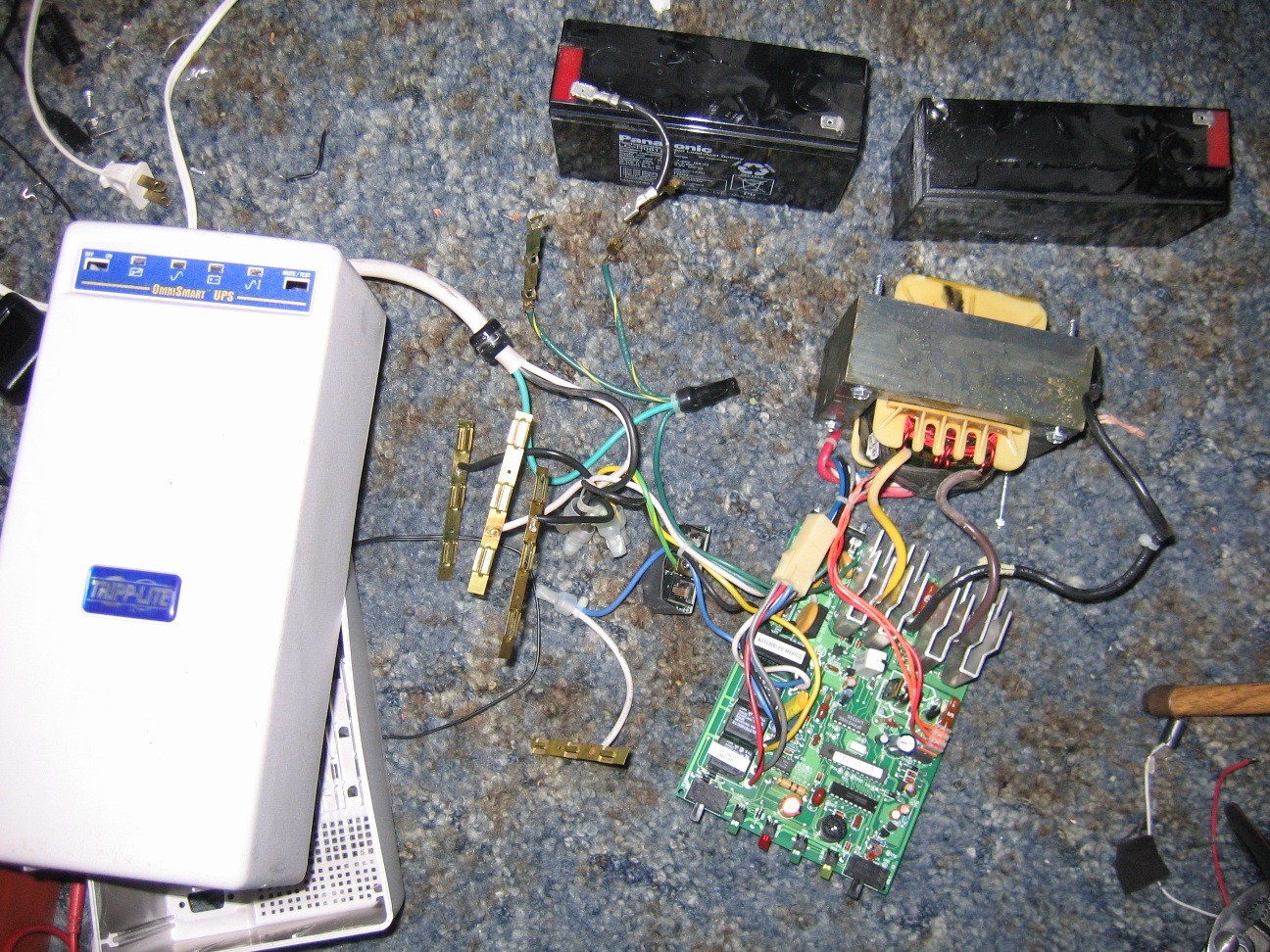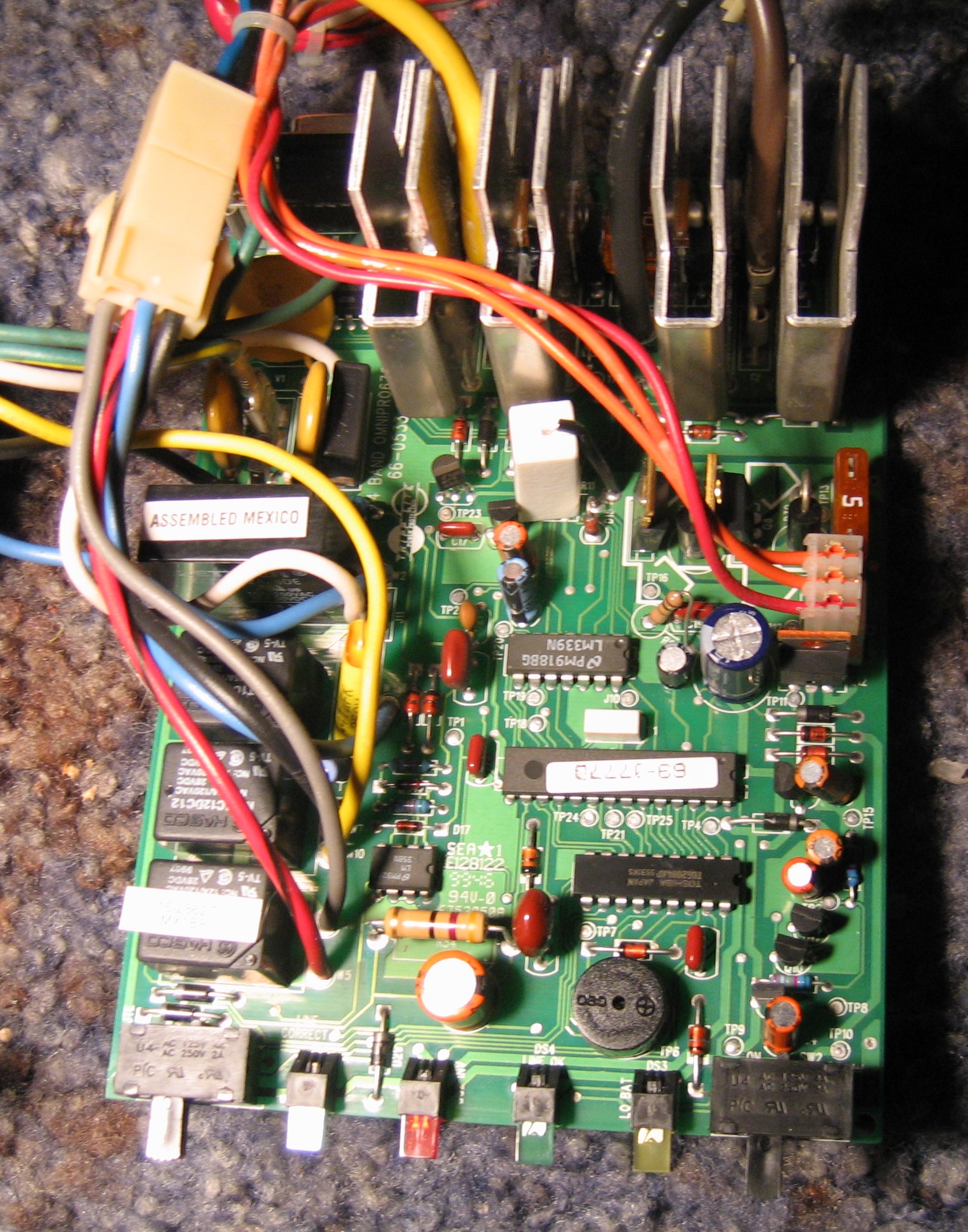UPS from the grave--looks great on Black and Blue
I found a UPS device at a local thrift store, tested it, and found it to be broken. As it didn't work I got lucky and the price came down from 20 bucks to 50 cents. The problem? I want it now to work, so I tore it apart to see what I could find. The first thing I checked was all the fuses--seemingly all functional. Then I checked the relays and none of them are stuck. When I power them on, I can even see the LED's glow that show what function they perform. The problem is it isn't doing it on it's own, whether I power it up by outlet or connect it by 12v battery. I just want it to work as a power inverter for a robot, and if I must I'll dedicate a Propeller cog to run it. I posted some rather large pictures so hopefully you can see it well, just tell me what I should try.
▔▔▔▔▔▔▔▔▔▔▔▔▔▔▔▔▔▔▔▔▔▔▔▔
Pi aren't squared, pi are round. Cornbread are squared!
Post Edited (pi'd) : 4/11/2010 11:11:46 PM GMT
▔▔▔▔▔▔▔▔▔▔▔▔▔▔▔▔▔▔▔▔▔▔▔▔
Pi aren't squared, pi are round. Cornbread are squared!
Post Edited (pi'd) : 4/11/2010 11:11:46 PM GMT




Comments
-Phil
▔▔▔▔▔▔▔▔▔▔▔▔▔▔▔▔▔▔▔▔▔▔▔▔
Check out my brand new site.
Kwinn, the batteries are all but dead. One holds 1/2v, the other 1/4! I may still try to use them, but in this case it doesn't matter because I used my robot's 12v 270 amp battery. Even when connected to that or connected to the outlet it won't power on. What I'm wondering is if I can turn on a relay to get it running, however I'm too nervous to try.
Also, I just found this. Perhaps it could help as long as the safety warnings are ignored:
www.tripplite.com/shared/techdoc/Owners-Manual/931308.pdf
▔▔▔▔▔▔▔▔▔▔▔▔▔▔▔▔▔▔▔▔▔▔▔▔
Pi aren't squared, pi are round. Cornbread are squared!
▔▔▔▔▔▔▔▔▔▔▔▔▔▔▔▔▔▔▔▔▔▔▔▔
Pi aren't squared, pi are round. Cornbread are squared!
1. can the frame ground the power supply when I do not have it plugged to a grounded outlet? will grounding the battery to the frame as well be alright as well without interference from the AC system?
2. When it is labeled for 425 watts, is that just when it is in the case under the advised temperature? Will fan cooling it allow me to achieve higher wattage?
3. Which is better and less noisy, powering the PDB and other electronics off the AC outlet, or limiting the current and powering it off the 12v battery?
Thanks for any answers. The questions don't seem too hard but may be important if I wish not to fry anything! This is new for me but I'm excited for what I can do.
▔▔▔▔▔▔▔▔▔▔▔▔▔▔▔▔▔▔▔▔▔▔▔▔
Pi aren't squared, pi are round. Cornbread are squared!
Here is the answer to that question so far as safety and generators are concerned. Quite a bit to that subject...
http://oshaprofessor.com/Portable%20Generators%20and%20OSHA%20Construction%20Standards%203-05.pdf
2 depends on how it is constructed. Odds are with sufficient heat sink and air flow you can increase your output. You will liky have to bypass some safety systems. There is a limit to how high you can go. What it is you will not know until you break it.
▔▔▔▔▔▔▔▔▔▔▔▔▔▔▔▔▔▔▔▔▔▔▔▔
Check out my brand new site.
▔▔▔▔▔▔▔▔▔▔▔▔▔▔▔▔▔▔▔▔▔▔▔▔
"When the government is afraid of the people there is liberty, when the people are afraid of the government, there is tryanny"
· Thomas Jefferson
·
What does it do? Well maybe you should look up UPS first... but I'm using it on my robot because I don't always plan to use it at home and I'm bound to run out of laptop power eventually. If I camp it wouldn't be to bad having a robot-run heater either! (Idaho gets cold)
@bill
"Your question #1 sure opens a can of worms!"
Well that sure sucks, sure wouldn't want to fry that laptop. Guess there's only one way to find out? But seriously could dragging a cable help? If my 150lb robot's steel frame isn't big enough for grounding I could always make it bigger...
mctriv--your first answer sounds good, but I may temporarily take the crazy way this weekend out of convenience but I'll create a board to improve it later to your method.
As for the second sounds good to me, but I was thinking more along the lines of a transistor addition, if that isn't too crazy. I'll have to think about it some more. Perhaps I could try it when my Tayda order comes in, I have some spares in the order.
Btw--like the new site Matt
Anyway thanks for the help everyone, and have a good rest of the evening.
▔▔▔▔▔▔▔▔▔▔▔▔▔▔▔▔▔▔▔▔▔▔▔▔
Pi aren't squared, pi are round. Cornbread are squared!
Why do you need grounding? I have not yet seen a laptop that is grounded. They are always insulated instead.
▔▔▔▔▔▔▔▔▔▔▔▔▔▔▔▔▔▔▔▔▔▔▔▔
Check out my brand new site.
▔▔▔▔▔▔▔▔▔▔▔▔▔▔▔▔▔▔▔▔▔▔▔▔
Pi aren't squared, pi are round. Cornbread are squared!
▔▔▔▔▔▔▔▔▔▔▔▔▔▔▔▔▔▔▔▔▔▔▔▔
Check out my brand new site.
I also have a large 2Kva rack mount APC that does frame tye the Batt - to frame but my smaller one does not.....
#2 kVA's and watts are 2 differnt beasts .. . depending on the load's powerfactor you can figure the amount you can draw .. . in the case of linear iron core UPSs its heat and input current .
I got a OLD triplite to allmost 2 times its rateings for long runs . in the end it was the CU traces that gave up the ghost .
Peter KG6LSE
▔▔▔▔▔▔▔▔▔▔▔▔▔▔▔▔▔▔▔▔▔▔▔▔
"Carpe Ducktum" "seize the tape!!"
peterthethinker.com/tesla/Venom/Venom.html
Never underestimate the bandwidth of a station wagon full of tapes hurtling down the highway. —Tanenbaum, Andrew S.
LOL
The issues with grounding and safety are that there would be 120 volts present on that board when connected to the battery...
If you are just using the board for charging the battery - no need for 120 VAC on the robot, then perhaps you could disconnect the board from the battery - say with a switch - after charging. Then no safety issues with the board because 120 V would not be present.
Then you would just need to be concerned with grounding *during* charging. And in that case you would want the charger and the metal frame of the robot grounded to the 120 VAC electrical ground. And the reason for this would be to protect from shock should a stray 120 volt wire touch the metal frame of the robot, then if grounded, this would cause a short on the electrical circuit and trip the circuit breaker - turning off the electricity.
And that is just safety... Then there is the possibility of ElectroMagnetic Interference (EMI) caused by the "making" of 60 cycles 120 VAC electricity. More on that here...
http://en.wikipedia.org/wiki/Electromagnetic_interference
http://en.wikipedia.org/wiki/Faraday_cage
Anyway, there are some good responses above. So since grounding to the battery and grounding to the frame are both ok can I do both? Hopefully because I plan to do that. Just out of curiosity, what is the real reason for grounding? Somehow I don't think it's to give the wires something to short on, I've been in welding to know that's more dangerous than it's worth!
▔▔▔▔▔▔▔▔▔▔▔▔▔▔▔▔▔▔▔▔▔▔▔▔
Pi aren't squared, pi are round. Cornbread are squared!
Post Edited (pi'd) : 4/9/2010 3:21:10 AM GMT
In the building/housing electrical world in the U.S. and Canada, they call the main electric system ground the "ground" or "grounding electrode conductor" (GEC). Then everything else is "bonded" to that ground. But manufacturers call the 3rd prong on a outlet the ground pin!
The rest of the world calls it "earthing"...
http://en.wikipedia.org/wiki/Earthing_system
This connection keeps·electrically conductive·parts at "earth potential"...
http://en.wikipedia.org/wiki/Ground_(electricity)
It will cause a circuit breaker to trip or a fuse to blow in the case of a fault...
http://www.littelfuse.com/protection-relays/introduction/ground-fault-protection-relays.html
It can keep electromagnetic emissions out or in with the use of shielding or a faraday cage...
http://en.wikipedia.org/wiki/Electromagnetic_interference
http://en.wikipedia.org/wiki/Faraday_cage
http://en.wikipedia.org/wiki/Shielded_cable
http://en.wikipedia.org/wiki/Electromagnetic_pulse
http://en.wikipedia.org/wiki/TEMPEST
Can protect buildings, trees, and antennas from lightning...
http://en.wikipedia.org/wiki/Lightning_rod
Can be used for voltage surge protection...
http://en.wikipedia.org/wiki/Surge_protector
Can be used for metal underground pipeline protection as part of a cathodic protection system...
http://en.wikipedia.org/wiki/Cathodic_protection
Can be used as half of an electrical circuit like with a vehicle chassis ground...
http://www.ese.upenn.edu/rca/instruments/misctutorials/Ground/grd.html
In Australia and Alaska,·it is used as one of the conductors of high voltage transmission lines (SWER)! (I kid you not!)...
http://en.wikipedia.org/wiki/Single-wire_earth_return
And you can have problems with grounding called a "ground loop"...
http://www.epanorama.net/documents/groundloop/
·
For anyone curious I have a picture of the temporary robot board I'm working on. The reason I'm calling it temporary is because I eventually want a metal case, but that may not happen until next school year. I still have to solder the parts to it--many of which are still coming in the mail--tomorrow, and after that maybe I can program it.
▔▔▔▔▔▔▔▔▔▔▔▔▔▔▔▔▔▔▔▔▔▔▔▔
Pi aren't squared, pi are round. Cornbread are squared!
▔▔▔▔▔▔▔▔▔▔▔▔▔▔▔▔▔▔▔▔▔▔▔▔
Pi aren't squared, pi are round. Cornbread are squared!
After rereading I'm thinking you may have to treat it as an electric forklift. The electrical systems of battery powered liftrucks and AVG's are NOT grounded to the frame like in typical 12v automotive systems, instead everything is returned to a common ground point.
The main reason for this was for static electricity buildup and the positive/negative voltages use in the drive controllers,computers, and inverters. Having a voltage to frame on something like a battery powered machine is a bad thing because if you happen to touch it you become the conductor to ground(or earth) and what ever voltages that had built up suddenly pass right on through you. It also causes computers/drive controllers to act abnormally.
The newer liftrucks and AVG's used 3phase AC drive and hydraulic motors that were powered by large inverters, those were just as problematic. The simple fix for all this was to bolt a plastic or rubber strip, to the frame, that had a high carbon content and let it drag on the ground.
This may or may not be a problem for you, just something that one should be aware of when working with battery powered mobile machines.
-dan
▔▔▔▔▔▔▔▔▔▔▔▔▔▔▔▔▔▔▔▔▔▔▔▔
Arguing with myself--sometimes me, myself, and I don't always agree.
(Former) Caterpillar product support technician
▔▔▔▔▔▔▔▔▔▔▔▔▔▔▔▔▔▔▔▔▔▔▔▔
Pi aren't squared, pi are round. Cornbread are squared!